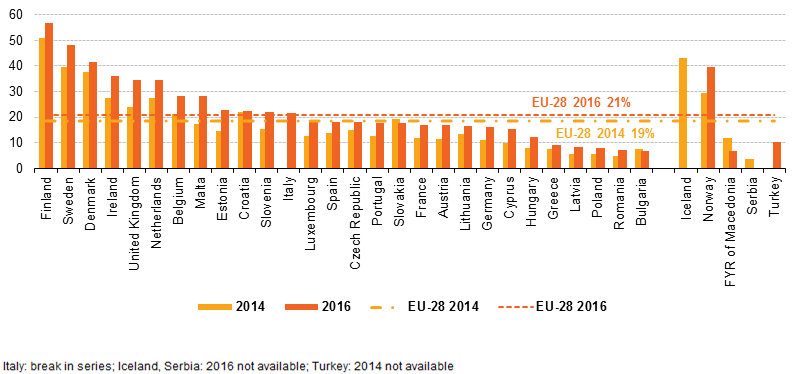Why Is Europe Slower to Embrace the Cloud?
The data centre model of IT is in decline. Cloud computing is now mainstream. And organisations are reaping the rewards through business agility, cost savings, scalable infrastructure on demand and access to modern cloud-based technologies.
However, despite the clear benefits, Europe is still lagging behind the US in terms of public cloud adoption. The three leading cloud providers, AWS, Microsoft Azure and Google, have built barely half the number of data centres across the entire continent compared with the US. Yet Europe has around twice the population.
According to a report published by Eurostat, just 21% of European organisations were using the cloud in some form in 2016. Statistics consistently point to a much higher proportion of cloud users in the US.
So what’s holding Europe back? In this post, we examine some of the issues preventing wider cloud adoption.
A Tangled Web of Regulation
One challenge in Europe is that, unlike the US, it isn’t a single country with a common set of regulations.
Each European country has its own data protection laws. And, under the EU country of origin principle, data is governed by the laws of the country in which it is processed and stored. So if, for example, a French company hosted data in the UK then this data would come under British rather than French jurisdiction.
This means any company hosting data in at least one other European country has to navigate a complex array of laws and directives concerning privacy and sharing. Moreover, as in the US, European national governments must store and process personal data within their own borders.
Data protection challenges aren’t just restricted to the EU. For example, Russia recently introduced legislation stating that personal data provided by Russian citizens online must be stored in data centres within the country. However, none of the three leading cloud providers currently has a presence in the country.
Likewise, the big three have yet to offer a data centre in France, Spain or Italy—although both AWS and Azure are due to launch a region in France in the coming months. But, in a nutshell, wider adoption may only come with the construction of more cloud data centres across the continent.
Impact of Brexit
A new EU law, the General Data Protection Regulation (GDPR), comes into force in May 2018, which will harmonize the individual data protection laws of all 28 member countries into a single set of EU-wide rules. This should open up new opportunities for cloud service providers by making it easier for countries both inside and outside of Europe to comply with data protection requirements.
However, the UK’s decision to leave the union in March 2019 means the government of Europe’s second largest economy will be able to change its data protection legislation. In view of recent changes to the UK’s current data privacy laws, the country still looks set to implement GDPR in full after it has left the union. Nevertheless, uncertainty surrounding the impact of Brexit could discourage IT investment in the cloud—all the more so as it has weakened sterling, making the cloud more expensive for UK users.
Stronger Scandinavian Growth
Scandinavian countries are leading the race to public cloud adoption. With far more relaxed data compliance rules than European neighbours, such as France and Germany, they offer better conditions for cloud technology to flourish.
Finland tops the league with the highest growth. It is a country with a long tradition of outsourcing IT services, which strongly aligns with the spirit of the cloud.
Both AWS and Google are cashing in on the growth in Scandinavia, with plans for data centres in Sweden and Finland respectively.
A Multifaceted Problem
The reason for slower cloud growth isn’t just isolated to data compliance. European countries still face other roadblocks to adoption. For example:
- Lingering security concerns: Despite the strong security features of the cloud, Europe still widely perceives it as less secure than on-premise data centres. What’s more, the widespread shortage of cloud security skills, which is particularly acute in the UK, has only served to compound the problem.
- Application latency: In many parts of Europe, the nearest cloud data centre could be more than a thousand miles away in another country. This can present latency issues for organisations serving a local user base.
- Financial constraints: Higher hourly rates for cloud regions based in Europe, combined with the continuing Euro crisis, are also making an impact on IT investments and migration to the cloud.
- Cloud skills shortage: Not only are security skills in short supply but also cloud expertise in general. This makes it all the more difficult for companies across the continent to move to the cloud.

Factors Limiting European Uptake of Cloud Services. Source Eurostat.
Massive Potential for Growth
Europe may have been slower to embrace the cloud. But as more cloud regions come online and the GDPR comes into force next year, the continent looks set for an explosion in opportunities for cloud-based IT services.
So now’s the time to prepare for the coming transformation. Research the various cloud vendor offerings, identify applications that are ripe for migration and put tools in place to help you succeed in a new, dynamic and modern IT environment.
Schedule a demo to learn how CloudCheckr can help you manage your cloud more effectively in EMEA.
Cloud Resources Delivered
Get free cloud resources delivered to your inbox. Sign up for our newsletter.
Cloud Resources Delivered
Subscribe to our newsletter
